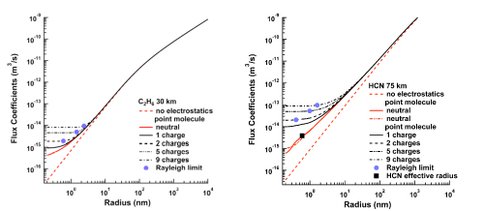2013 Annual Science Report
 NASA Jet Propulsion Laboratory - Titan
Reporting | SEP 2012 – AUG 2013
NASA Jet Propulsion Laboratory - Titan
Reporting | SEP 2012 – AUG 2013
Task 2.2.1: Characterization of Aerosol Nucleation & Growth on Titan
Project Summary
The scientific goal of this task is to elucidate the mechanisms and develop a quantitative understanding of particle formation and growth in the Titan atmosphere.
Project Progress
This work has focused on the vapor nucleation and condensation onto pre-existing particles under conditions in various regions of Titan’s atmosphere. The rate of increase of particle mass is the sum of contributions of different vapors. For particles that are small compared to the mean-free-path of the vapor molecules, λ, the flux is described by the kinetic theory of gases; for particles large compared to λ, the continuum diffusion modeling can be applied. Over the entire range of sizes, the flux is described using the continuum model, with a correction factor that accounts for deviations from free molecular mass transport effects.
Condensation fluxes are also influenced by dipole and Coulombic interactions for particles smaller than about 10 nm radius, as illustrated for C2H6 condensation at 30 km altitude in the Titan atmosphere in Figure 1a, below. For more polar vapor molecules, deviations from simple condensation molecules can extend to much larger particle sizes, as shown for HCN in Figure 1b below.
-
PROJECT INVESTIGATORS:
-
PROJECT MEMBERS:
Richard Flagan
Project Investigator
-
RELATED OBJECTIVES:
Objective 3.1
Sources of prebiotic materials and catalysts
